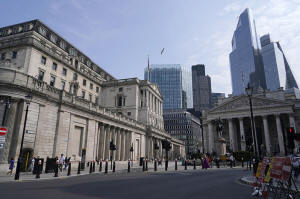|
The
latest reading from the Office of National Statistics means
inflation remains just above the Bank of England's target of 2%.
Last month, the central bank reduced its main interest rate by a
quarter-point to 5%, the first cut since the onset of the
pandemic.
Central banks around the world dramatically increased borrowing
costs from near zero during the coronavirus pandemic when prices
started to shoot up, first as a result of supply chain issues
built up during the pandemic and then because of Russia’s
full-scale invasion of Ukraine which pushed up energy costs.
Most economists think the bank will opt to keep borrowing costs
unchanged after its latest policy meeting on Thursday as a
majority of the nine-member Monetary Policy Committee remains
wary about inflation in the crucial services sector. Wednesday's
data showed that services sector inflation jumped to 5.6% in
August from 5.2% in July as a result of higher air fares across
European routes.
However, they think that the bank will most likely cut again in
November, in the wake of the government's budget on Oct. 30.
The new Labour government has said that it needs to plug a 22
billion-pound ($29 billion) hole in the public finances and has
indicated that it may have to raise taxes and lower spending,
which would likely weigh on the near-term outlook for the
British economy and put downward pressure on inflation.
“An interest rate cut on Thursday is looking unlikely with the
majority of the Monetary Policy Committee likely to want to
assess the impact of next month’s budget before deciding when to
loosen policy again," said Suren Thiru, economics director at
the Institute of Chartered Accountants in England and Wales.
Central banks around the world have started cutting interest
rates as inflation rates have fallen from multi-decade highs.
Later Wednesday, the U.S. Federal Reserve is expected to cut
rates for the first time in four years.
All contents © copyright 2024 Associated Press. All rights
reserved

|
|




